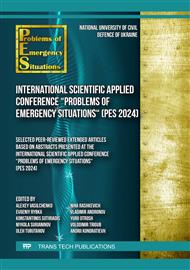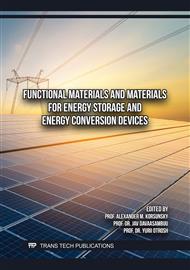[1]
N. Magas, G. Trokhymenko, V. Blagodatnyi, Development of procedure for assessing the degree of enviromental hazard from the sources of aquatic environment pollution. Eastern-European Journal of Enterprise Technologies. 5(10-95) (2018) 56–65.
DOI: 10.15587/1729-4061.2018.143804
Google Scholar
[2]
K. Tsytlishvili, N. Rashkevich, D. Poltavska, Research of Modern technologies of Wastewater Treatment of Food Products Combined with Ozonation and Hydrogen Peroxide. Key Engineering Materials. 925 (2022) 169–178.
DOI: 10.4028/p-t5m3y6
Google Scholar
[3]
A. Myroshnychenko, V. Loboichenko, M. Divizinyuk, A. Levterov, N. Rashkevich, O. Shevchenko, R. Shevchenko, Application of Up-to-Date Technologies for Monitoring the State of Surface Water in Populated Areas Affected by Hostilities. Bulletin of the georgian national academy of sciences. 16 3 (2022) 50–59.
Google Scholar
[4]
N. Rashkevich, R. Shevchenko, I. Khmyrov, A. Soshinskiy, Investigation of the Influence of the Physical Properties of Landfill Soils on the Stability of Slopes in the Context of Solving Civil Security Problems. Materials Science Forum. 1038 (2021) 407–416.
DOI: 10.4028/www.scientific.net/msf.1038.407
Google Scholar
[5]
M. Malovanyy, O. Moroz, V. Popovich, M. Kopiy, I. Tymchuk, A. Sereda, G. Krusir, Ch. Soloviy, The perspective of using the «open biological conveyor» method for purifying landfill filtrates, Environmental Nanotechnology. Monitoring & Management. 16 (2021) 100611.
DOI: 10.1016/j.enmm.2021.100611
Google Scholar
[6]
V. Ptashnyk, I. Bordun, M. Malovanyy, P. Chabecki, T. Pieshkov, The change of structural parameters of nanoporous activated carbons under the influence of ultrasonic radiation. Applied Nanoscience (Switzerland). 10(12) (2020) 4891–4899.
DOI: 10.1007/s13204-020-01393-z
Google Scholar
[7]
M. Malovanyy, O. Palamarchuk, I. Trach, H. Petruk, H. Sakalova, Kh. Soloviy, T. Vasylinych, I. Tymchuk, N. Vronska, Adsorption Extraction of Chromium Ions (III) with the Help of Bentonite Clays. Journal of Ecological Engineering. 21(7) (2020) 178–185.
DOI: 10.12911/22998993/125545
Google Scholar
[8]
L. Henthorne, B. Boysen, State-of-the-art of reverse osmosis desalination pretreatment, Desalination. 356 (2015) 129–139.
DOI: 10.1016/j.desal.2014.10.039
Google Scholar
[9]
E.E. Kostenko, L. Melnyk, S. Matko, M. Malovanyy, The use of sulphophtalein dyes immobilized on anionite Ab-17X8 to determine the contents of Pb(Ii), Cu(Ii), Hg(Ii) and Zn(Ii) in liquid medium. Chemistry & Chemical Technology. 11(1) (2017) 117–124.
DOI: 10.23939/chcht11.01.117
Google Scholar
[10]
K. Vikrant, B.S. Giri, N. Raza, K. Roy, K. Kim, B.N. Rai, R.S. Singh, Recent advancements in bioremediation of dye: current status and challenges. Bioresour. Technol. 253 (2018) 355–367.
DOI: 10.1016/j.biortech.2018.01.029
Google Scholar
[11]
I. Tymchuk, M. Malovanyy, O. Shkvirko, V. Zhuk, A. Masikevych, S. Synelnikov, Innovative creation technologies for the growth substrate based on the man-made waste - perspective way for Ukraine to ensure biological reclamation of waste dumps and quarries. International Journal of Foresight and Innovation Policy. 14(2/3/4) (2020) 248–263.
DOI: 10.1504/ijfip.2020.10033249
Google Scholar
[12]
I. Tymchuk, M. Malovanyy, O. Shkvirko, N. Chornomaz, O. Popovych, R. Grechanik, D. Symak, Review of the global experience in reclamation of disturbed lands. Inzynieria Ekologiczna. 22(1) (2021) 24–30.
DOI: 10.12912/27197050/132097
Google Scholar
[13]
Y. Budash, V. Plavan, N. Tarasenko, O. Ishchenko, M. Koliada, Effect of Acid Modification on Porous Structure and Adsorption Properties of Different Type Ukrainian Claysfor Water Purification Technologies. Journal of Ecological Engineering. 24(5) (2023) 210–221.
DOI: 10.12911/22998993/161691
Google Scholar
[14]
O. Khudoyarova, O. Gordienko, T. Sydoruk, T. Titov, S. Prokopchuk, Adsorptive desulfurization of sewage of industrial. Environmental problems. 2 (2020) 102–106.
Google Scholar
[15]
A.P. Ranskiy, O.S. Khudoyarova, O.A. Gordienko, T.S. Titov, R.D. Kryklyvyi, Regeneration of Sorbents Mixture After the Purification of Recycled Waterin Production of Soft Drinks. J. Water Chem. Technol. 5 (2019) 318–321.
DOI: 10.3103/s1063455x19050084
Google Scholar
[16]
O.V. Kyrychenko, Mineralogical composition and thermal transformation natural and iron – modified bentonite clays. Naukovyy visnyk NLTU Ukrayiny. 20.3 (2010) 77–82.
Google Scholar
[17]
Information on https://www.aolongxray.com/product-list/x-ray-pipeline-crawler?gclid= EAIaIQobChMI2uiGxMjXgwMVFlCRBR0OuQR9EAAYASAAEgJLhPD_BwE
Google Scholar
[18]
I. Bordun, T. Vasylinych, M. Malovanyy, H. Sakalova, L. Liubchak, L. Luchyt, Study of adsorption of differently charged dyes by carbon adsorbents. Desalination and water treatment. 288 (2023) 151–158.
DOI: 10.5004/dwt.2023.29332
Google Scholar



